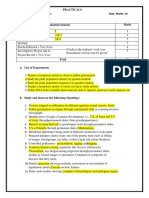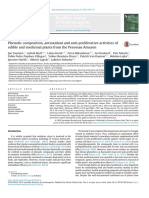Practical QP 2023
Practical QP 2023
Uploaded by
Amrita SCopyright:
Available Formats
Practical QP 2023
Practical QP 2023
Uploaded by
Amrita SOriginal Title
Copyright
Available Formats
Share this document
Did you find this document useful?
Is this content inappropriate?
Copyright:
Available Formats
Practical QP 2023
Practical QP 2023
Uploaded by
Amrita SCopyright:
Available Formats
CENTRAL BOARD OF SECONDARY EDUCATION
AISSCE – MOCK PRACTICAL EXAMINATION -2023
BIOLOGY (044)
CENTER NAME: ADITYA VIDYASHRAM RESIDENTIAL SCHOOL
TIME: 3 HRS MARKS: 30
Section – A (9 Marks)
1. Perform an experiment to extract DNA from the given sample. Write the aim, apparatus required
procedure, observation & diagram and precaution. 5 marks
(Experiment to extract DNA – 1 m, Aim- 1/2m, Apparatus required – 1/2m, Procedure-1m, observation - 1/2m,
diagram 1/2m, Precation-1m)
2. Find the Frequency percentage(or) Density of the vegetation by observing the quadrats given.
(Aim – 1 m Observations and Tabulation – 2 m, Result-1m) 4 marks
Section – B (5 Marks)
3. Prepare a temporary slide to show the pollen germination in nutrient medium and Calculate the
percentage of germination (or) Onion root tip – Mitosis stages observation.
( Preparation of slide – 1m, Procedure – 2m, Observation - 1/2m, Diagrams -1/2m, Result & Precautions – 1m)
Section – C (7 X 1 = 7 Marks)
4. Identify the slides or specimens or models or pictures and comment on each according to the
instruction given.
A. Identify the Plant /Photograph arranged and write the type of pollination taking place in it.
(Identification of pollinating agent: ½ m, Characters of the plant that helps in pollination process: ½ m)
B. Identify the spotter and add comments.
(Identification and Diagram: ½ m, two comments: ½ m)
C. Identify the kind of cross and write the punnet square .
(Identification of the kind of cross: ½ m and Punnet square for the cross: ½ m)
D. Identify the disease causing organism and comment.
(Scientific Name of the organism: ½ m, two comments ½ m)
E. Identify the picture and relate it to its origin and function and add comment.
(Identification: ½ m, comments: ½ m)
F. Identify the set up and write the comments.
(Identification ½ m, two adaptations: ½ m)
G. Identify the given chart and write two comments (Identification: ½ m, two comments: ½ m)
5. Section – D (4 Marks) Practical record – 2 m Viva- voice 2 m
6. Section – E (5 Marks) Investigatory project – 3 m Viva- voice 2 m
A. List of Experiments
1. Prepare a temporary mount to observe pollen germination. (Qn. No. 1)
2. Study the plant population density by quadrat method. (Qn. No. 2 either or)
3. Study the plant population frequency by quadrat method. (Qn. No. 2 either or)
4. Prepare a temporary mount of onion root tip to study mitosis. (Qn. No. 3 either or)
5. Isolate DNA from available plant material such as spinach, green pea seeds, papaya, etc. (Qn. No. 3 either or)
B. Study and observer the following (Spotting): ANY SEVEN FROM THE FOLLOWING WILL BE
GIVEN. (Section- C)
1. Flowers adapted to pollination by different agencies (wind, insects, birds).
2. Pollen germination on stigma through a permanent slide or scanning electron micrograph.
3. Identification of stages of gamete development, i.e., T.S. of testis and T.S. of ovary through permanent slides
(from grasshopper/mice).
4. Meiosis in onion bud cell or grasshopper testis through permanent slides.
5. T.S. of blastula through permanent slides (Mammalian).
6. Mendelian inheritance using seeds of different colour/sizes of any plant.
7. Prepared pedigree charts of any one of the genetic traits such as rolling of tongue, blood groups, ear lobes,
widow's peak and colour blindness.
8. Controlled pollination - emasculation, tagging andbagging.
9. Common disease causing organisms like Ascaris, Entamoeba, Plasmodium, any fungus causing ringworm
through permanent slides, models or virtual images or specimens. Comment on symptoms of diseases that they
cause.
10. Models specimen showing symbolic association in root modules of leguminous plants, Cuscuta on host,
lichens.
11. Flash cards models showing examples of homologous and analogous organs.
MATERIAL TO BE BROUGHT BY THE STUDENTS for MOCK PRACTICAL:
1. PAPAYA – FULLY RIPEN – FOR BETTER RESULT
2. FLOWER FOR POLLEN GERMINATION – PREFERABLY Datura metal or any other
flowers like Hibiscus
You might also like
- Class 12 Biology Lab Manual Practical Content 2023-24-1Document14 pagesClass 12 Biology Lab Manual Practical Content 2023-24-1Geetanjali Saraswat91% (11)
- A - Service Centenary Issue - Burmese Forester - Selected ArticlesDocument146 pagesA - Service Centenary Issue - Burmese Forester - Selected ArticlesMaung Maung Than100% (1)
- Algonquian EthnobotanyDocument69 pagesAlgonquian Ethnobotanyjdlayden90% (10)
- Herbal PlantsDocument21 pagesHerbal Plantshan_angelaNo ratings yet
- Ultimate Pokedex + Indices 1.05 CompressedDocument1,015 pagesUltimate Pokedex + Indices 1.05 CompressedjeremiahNo ratings yet
- Spawn Production TechnologyDocument8 pagesSpawn Production TechnologythosampaNo ratings yet
- Practical Biology (CBSE)Document1 pagePractical Biology (CBSE)farshana07No ratings yet
- XII Practical NotesDocument6 pagesXII Practical NotesjayasuryaneetNo ratings yet
- BIOLOGY PRACTICAL ASSESSMENT 2024Document3 pagesBIOLOGY PRACTICAL ASSESSMENT 2024iburg558No ratings yet
- Bio Practical Set 1Document3 pagesBio Practical Set 1Navneet ChoudharyNo ratings yet
- Biology Lab Study MaterialDocument7 pagesBiology Lab Study MaterialNishanth PNo ratings yet
- Class 12 Biology Practicals (2022 - 23)Document2 pagesClass 12 Biology Practicals (2022 - 23)Akshay Pandey0% (1)
- Biology Lab Manual 2024-25Document47 pagesBiology Lab Manual 2024-25msimnaapsbNo ratings yet
- XII Biology Practicals 2022-23Document24 pagesXII Biology Practicals 2022-23kuntalsaikia82No ratings yet
- 12 Biology Practical List 2024 - 25Document1 page12 Biology Practical List 2024 - 25www.tarunapanwarNo ratings yet
- XII Practs Syll. 2023-24Document1 pageXII Practs Syll. 2023-24trugamzerNo ratings yet
- Mid Term - Bio PractDocument1 pageMid Term - Bio Practafsanashaheen47No ratings yet
- Biology Lab Manual 2024-25Document46 pagesBiology Lab Manual 2024-25YASH PRATAPNo ratings yet
- DSSCE CBSE Bio Practical 2023Document1 pageDSSCE CBSE Bio Practical 2023sumankaswa841No ratings yet
- 12th std Biology lab 2025Document2 pages12th std Biology lab 2025again8092No ratings yet
- Biology_QPDocument1 pageBiology_QPdeepshikhaetgNo ratings yet
- 12th Bio PracticalDocument2 pages12th Bio Practicalneetesh23novNo ratings yet
- Biology Practicals PDFDocument23 pagesBiology Practicals PDFLalitha SrinuNo ratings yet
- XII LIST OF PRACTICAL EXPERIMENTS - Biology 2022-23Document1 pageXII LIST OF PRACTICAL EXPERIMENTS - Biology 2022-23Ali AhmedNo ratings yet
- Iipuc Practicals - 2022Document8 pagesIipuc Practicals - 2022prajnap289No ratings yet
- 12 Biology Practical 2024-25Document2 pages12 Biology Practical 2024-25Uttam KumarNo ratings yet
- Adobe Scan 01 Jun 2024Document14 pagesAdobe Scan 01 Jun 2024sujal.singh18decNo ratings yet
- 23-24 Xii Biology Lab ManualDocument59 pages23-24 Xii Biology Lab ManualS.Monees BalaaNo ratings yet
- Class XII Biology Practical 2022-23Document23 pagesClass XII Biology Practical 2022-23karishmaNo ratings yet
- Biology Lab ManualDocument53 pagesBiology Lab ManualTonique Gordon100% (3)
- Class 12th Biology Practical FileDocument2 pagesClass 12th Biology Practical Filenothingcaming12No ratings yet
- Practical 12thDocument9 pagesPractical 12thKushagra MishraNo ratings yet
- BiologyDocument13 pagesBiologyaccprivate411No ratings yet
- 2 Year Puc Practical Examination: Subject: Biology (36) Question PaperDocument3 pages2 Year Puc Practical Examination: Subject: Biology (36) Question PaperTommy100% (1)
- practical 1Document36 pagespractical 1gogomayyaaNo ratings yet
- XII Bio Practical Material 2024-25Document28 pagesXII Bio Practical Material 2024-25Atanu RoyNo ratings yet
- Blue Print of Biology Practicals-1Document3 pagesBlue Print of Biology Practicals-1Ayush SinghNo ratings yet
- Manual BiodiveristyDocument17 pagesManual BiodiveristyDave Daniel MarmitaNo ratings yet
- Federal University of Technology, P.M.B. 1526, Owerri, Imo StateDocument40 pagesFederal University of Technology, P.M.B. 1526, Owerri, Imo StateEverpeeNo ratings yet
- Practical Manual - Field Diagnosis in AgricultureDocument127 pagesPractical Manual - Field Diagnosis in AgriculturePrakash Kumar KumarNo ratings yet
- 12 PraDocument30 pages12 Praxelivo8277No ratings yet
- Biology Practicals at A Glance 2021-22 (Class Xii: Cbse)Document41 pagesBiology Practicals at A Glance 2021-22 (Class Xii: Cbse)Pulkit BansalNo ratings yet
- CLASS XII BIOLOGY PROJECT WORK 2Document1 pageCLASS XII BIOLOGY PROJECT WORK 2yuji07581No ratings yet
- Birds Soco PaperDocument21 pagesBirds Soco PaperSurbhi GuptaNo ratings yet
- BIOLOGY LAB MANUAL- XII - 2024 - 25Document39 pagesBIOLOGY LAB MANUAL- XII - 2024 - 25jatinmehra1415No ratings yet
- 12 TH Biology Board Syllabus (1) Ahadbad MaDocument4 pages12 TH Biology Board Syllabus (1) Ahadbad MaKartikey LakhaniNo ratings yet
- Hssreporter - Com - HSE Botany Practical Exam Guidelines 2023-24Document2 pagesHssreporter - Com - HSE Botany Practical Exam Guidelines 2023-24joyalyt8No ratings yet
- Biology PracticalDocument9 pagesBiology Practicalghoshadrish2007No ratings yet
- Publi Arium Flow Cytometry e DataDocument4 pagesPubli Arium Flow Cytometry e Dataamlmahmoudgad124No ratings yet
- Class 12 Bio PracticalsDocument2 pagesClass 12 Bio PracticalsAbhinavchoudharyNo ratings yet
- Biology PracticalsDocument42 pagesBiology Practicalsꜱ.ꜱʀɪᴠᴀʀꜱнᴀɴNo ratings yet
- Keywords: Bactrocera Dorsalis Complex, Wing Image Processing, Morphometric, Discriminant and Cluster AnalysesDocument13 pagesKeywords: Bactrocera Dorsalis Complex, Wing Image Processing, Morphometric, Discriminant and Cluster AnalysesChahyadi ennieNo ratings yet
- Ipuc PRCTCLQP BioDocument3 pagesIpuc PRCTCLQP BioVinayaka KV BhatNo ratings yet
- 12 practicals2024Document2 pages12 practicals2024Thajreem gafoorNo ratings yet
- 2025 12 Biology SyllabusDocument6 pages2025 12 Biology Syllabuskanishksajankar735No ratings yet
- Statistics Questions Practice W2 Final 1Document23 pagesStatistics Questions Practice W2 Final 1Ameen Hussain Fahmy100% (1)
- XII_BIOLOGY PRACTICAL NOTES_New_2024-2025Document10 pagesXII_BIOLOGY PRACTICAL NOTES_New_2024-2025v31798097No ratings yet
- evidence collectionDocument6 pagesevidence collectionchrispusng254No ratings yet
- Practical Reference Material 2024-25Document14 pagesPractical Reference Material 2024-25zayarock1No ratings yet
- 12 Bio Practicals PDFDocument1 page12 Bio Practicals PDFAyushi Kayal100% (1)
- The Most Effective Method To Recognize and Assess Bugs in Food GrainsDocument10 pagesThe Most Effective Method To Recognize and Assess Bugs in Food GrainsIJRASETPublicationsNo ratings yet
- Holiday Homework Class 12Document2 pagesHoliday Homework Class 12craftodio6No ratings yet
- BIOLOGYDocument2 pagesBIOLOGYanoopstudieNo ratings yet
- Frequency, Abundance and Density of Plant Species by List Count Quadrat MethodDocument8 pagesFrequency, Abundance and Density of Plant Species by List Count Quadrat MethodAnna13100% (1)
- Notes - Reproduction-1Document19 pagesNotes - Reproduction-1Nathan mwapeNo ratings yet
- Ascent of Sap: 3 Theories: (A) Godlewski S Relay-Pump TheoryDocument11 pagesAscent of Sap: 3 Theories: (A) Godlewski S Relay-Pump TheoryRahulBansumanNo ratings yet
- THROUGH THE EYES OF A TREE, Shruti Shree DashDocument2 pagesTHROUGH THE EYES OF A TREE, Shruti Shree DashShruti Shree DashNo ratings yet
- Phenolic Composition, Antioxidant and Anti-Proliferative Activities of Edible and Medicinal Plants From The Peruvian AmazonDocument10 pagesPhenolic Composition, Antioxidant and Anti-Proliferative Activities of Edible and Medicinal Plants From The Peruvian AmazonPaulo RiceliNo ratings yet
- Seasons of BengalDocument10 pagesSeasons of BengaljhalakduttaNo ratings yet
- Plant Cell WallsDocument18 pagesPlant Cell WallsAhmed OmarNo ratings yet
- CSA Brochure 2014Document2 pagesCSA Brochure 2014Megan HaneyNo ratings yet
- FBS 221 Lab - Edited With QuestionsDocument10 pagesFBS 221 Lab - Edited With QuestionsashleyNo ratings yet
- Class 7 Science Chapter Reproduction in PlantsDocument37 pagesClass 7 Science Chapter Reproduction in PlantsUjjal BhattacharjeeNo ratings yet
- Cpop - Prot .InsectDocument17 pagesCpop - Prot .InsectAlvin WatinNo ratings yet
- Tree Bark K-2 - 0Document2 pagesTree Bark K-2 - 0zackytgameNo ratings yet
- English TestDocument2 pagesEnglish Testsiti annurNo ratings yet
- (ARCHIVED) 8040 9040 GCE Biology International PDFDocument33 pages(ARCHIVED) 8040 9040 GCE Biology International PDFVictor EnglishNo ratings yet
- Math Story FlowersDocument3 pagesMath Story Flowerstoxic_angel_love958No ratings yet
- Utilization of Pili Flour As TeaDocument36 pagesUtilization of Pili Flour As TeaClyde Tabligan100% (5)
- The Human and Plant Reproductive System: Threesha Gee Maree A. Bahingawan, LPTDocument31 pagesThe Human and Plant Reproductive System: Threesha Gee Maree A. Bahingawan, LPTAyessa Gomez CerezoNo ratings yet
- Alerone LayerDocument11 pagesAlerone LayervijendNo ratings yet
- January 2012 QP - Unit 4 Edexcel Biology A-LevelDocument24 pagesJanuary 2012 QP - Unit 4 Edexcel Biology A-LevelElissa MeflehNo ratings yet
- Biology Practical Notebook Standard XIIDocument5 pagesBiology Practical Notebook Standard XIIpinkysabavaNo ratings yet
- Care Sheet - Pied Warty FrogDocument2 pagesCare Sheet - Pied Warty FrogJohn GamesbyNo ratings yet
- Science - 5 Second Quarter ExamDocument4 pagesScience - 5 Second Quarter ExamRex Russel SalemNo ratings yet
- Flowers Flashcards - Little Ladoo (2) - UnlockedDocument19 pagesFlowers Flashcards - Little Ladoo (2) - UnlockedRanta Printing dan PercetakanNo ratings yet
- Soft LandscapeDocument45 pagesSoft LandscapeIqram Meon100% (1)
- SR Neet Star Super Chaina (Biology GT-1) Ex - Dt. 20.11.2024Document14 pagesSR Neet Star Super Chaina (Biology GT-1) Ex - Dt. 20.11.2024adeenfalahNo ratings yet
- The Kai Wire: AsiseeitDocument6 pagesThe Kai Wire: AsiseeitemteechicagoNo ratings yet

























































































